Anglesey Abbey
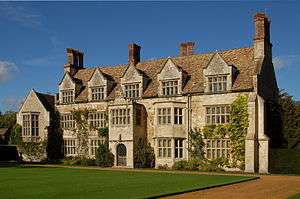
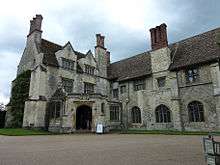
Anglesey Abbey is a country house, formerly a priory, in the village of Lode, 5 1⁄2 miles (8.9 km) northeast of Cambridge, England. The house and its grounds are owned by the National Trust and are open to the public as part of the Anglesey Abbey, Gardens and Lode Mill property,[1] although some parts remain the private home of the Fairhaven family.
The 98 acres (400,000 m2) of landscaped grounds are divided into a number of walks and gardens, with classical statuary, topiary and flowerbeds. The grounds were laid out in an 18th-century style by the estate's last private owner, The 1st Baron Fairhaven, in the 1930s. A large pool, the Quarry Pool, is believed to be the site of a 19th-century coprolite mine. Lode Water Mill, dating from the 18th century [2] was restored to working condition in 1982 and now sells flour to visitors.
The 1st Lord Fairhaven also improved the house and decorated its interior with a valuable collection of furniture, pictures and objets d'art.
History
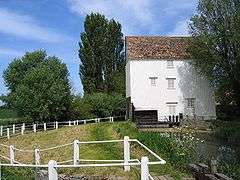
A community of Augustinian canons built a priory here, known as Anglesea or Anglesey Priory, some time during the reign of Henry I (i.e., between 1100 and 1135), and acquired extra land from the nearby village of Bottisham in 1279. The canons were expelled in 1535 during the Dissolution of the Monasteries.[3]
The former priory was acquired around 1600 by Thomas Hobson, who converted it to a country house for his son-in-law, Thomas Parker, retaining a few arches from the original priory. At that time the building's name was changed to "Anglesey Abbey", which sounded grander than the original "Anglesey Priory".
In the late 18th century, the house was owned by Sir George Downing, the founder of Downing College, Cambridge.
Further alterations to the building were carried out in 1861.
Huttleston (1896–1966) and Henry (1900–1973) Broughton bought the site in 1926 and made improvements to the house. They were the sons of Urban Broughton (1857–1929), who had made a fortune in the mining and railway industries in America. Henry married, leaving the abbey to his brother, then 1st Lord Fairhaven, in 1930. Henry later became the 2nd Lord Fairhaven. Meanwhile, the 1st Lord Fairhaven used his wealth to indulge his interests in history, art, and garden design, and to lead an eighteenth-century lifestyle at the house. On his death in 1966, Lord Fairhaven left the abbey to the National Trust so that the house and gardens could "represent an age and way of life that was quickly passing".
Huttleston, 1st Baron Fairhaven

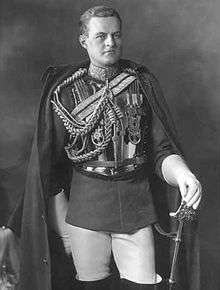
In 1926, Anglesey Abbey was bought by Huttleston Broughton, later Lord Fairhaven, and his brother Henry. The 1st Lord Fairhaven fully restored the house which had fallen into disrepair and began to collect beautiful furniture, artworks and statuary. All of these can be seen at the Abbey today.
The Rt Hon. Urban Huttleston Broughton, 1st Baron Fairhaven, was born in 1896 in Fairhaven, Massachusetts. His father, Urban H. Broughton, had amassed a considerable fortune. His mother was Cara Leland Rogers, the daughter of multimillionaire American oil magnate Henry Huttleston Rogers. Rogers had died unexpectedly in 1909 and Urban Broughton had taken over the management of a large part of the Rogers empire.[4]
The Broughton family had moved to England in 1912 when Huttleston was sixteen. They lived in Park Lane, Mayfair. Huttleston was educated at Harrow and the Royal Military Academy at Sandhurst. In 1916 he became a lieutenant in the 1st Life Guards. He served during the First World War, and retired from the military in 1924.[5] He obtained the title Baron Fairhaven in 1929.
One of the great achievements of the 1st Lord Fairhaven was the establishment of the garden at the house. In 1964, when the 1st Lord Fairhaven was still living, Lanning Roper wrote a book entitled The Gardens of Anglesey Abbey,[6] in which he described the careful planning of this remarkable garden with its many vistas, avenues, rare and common trees, pools, statues and river temples. He describes the way in which huge areas of sky and mown grass were used to balance symmetrical planting and how Lord Fairhaven used the trees and shrubs to make groups of contrasting colour and foliage.
To commemorate the coronation of King George VI and Queen Elizabeth in 1937, Lord Fairhaven planted an extensive avenue of trees with a crossing avenue at the far end. The trees used were London plane alternating with horse chestnut in four rows, copying those planted in Windsor Great Park.[7]
The 1st Lord Fairhaven did not marry and had no heirs. He died in 1966 and left Anglesey Abbey to the National Trust.
The first-ever biography of Lord Fairhaven, Finding Fairhaven: A Search for the Shy Lord of Anglesey Abbey, by Tom Hickman, published in May 2017, is available on Amazon (£10.99).
Origin of the name
The name Anglesey is not a reference to the Welsh island known as Anglesey in English, although the two names do have some etymology in common. Anglesey Priory was built on what was, before improvements in the drainage of the area, an island. In both place names, as in many other place names in Britain, the final -ey is from a Germanic word meaning 'isle'. In the case of the Welsh island, Angle- is from an Old Norse word ǫngull, which is either a personal name, or a word meaning 'angle' or 'corner'. In the case of the Priory, Angle- is probably a reference to the Angles, a Germanic people who invaded the east of England in the 5th century. The anterior origin of this name is debatable, with some versions linking it to 'angle', a reference to the shape of their homeland, and others claiming a reference to 'angling'. However, it is likely that the name refers to the fact that the Fens and its islands were home to a native British (Brythonic) population, and that the Angles were an island community within a predominantly Celtic landscape.
Gardens
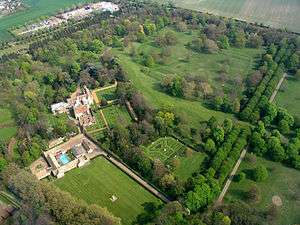
The extensive landscaped gardens are popular with visitors throughout the year. The most visited areas include the rose garden and the dahlia garden, which contain many dozens of varieties. Out of season the spring garden and winter dell are famed nationally, particularly in February when the snowdrops first appear. The lawns of the South Park are mown less frequently and this allows the many wildflowers to flower and set seed. Over 50 species of wildflower have been recorded, including bee orchid, twayblade, pyramidal orchid and common spotted orchid. In mid-summer, there are large numbers of butterflies such as meadow brown, gatekeeper, small skippers and marbled whites.
 Snowdrops in front of the house
Snowdrops in front of the house Rose Garden
Rose Garden Formal Garden with hyacinths in spring
Formal Garden with hyacinths in spring Part of the "Winter Walk" in spring
Part of the "Winter Walk" in spring Winter Walk in summer
Winter Walk in summer Coronation Avenue
Coronation Avenue The Circular Temple
The Circular Temple
Notes
- ↑ Anglesey Abbey, Gardens and Lode Mill
- ↑ Lode Water Mill - Anglesey Abbey Archived August 7, 2007, at the Wayback Machine.
- ↑ Catholic Encyclopedia: The Priory of Anglesea, accessed 28 June 2017
- ↑ Millicent Library, Fairhaven, Massachusetts. Online reference "Archived copy". Archived from the original on 2009-01-20. Retrieved 2009-10-01.
- ↑ Obituary: Urban Huttleston Rogers Broughton, Alumni Horae Volume 47, Issue 2, Page 131. Online reference "Archived copy". Archived from the original on 2013-12-28. Retrieved 2012-02-08.
- ↑ Roper, Lanning 1964 The Gardens of Anglesey Abbey, Faber and Faber, Cambridgeshire.
- ↑ Thomas, Graham Stuart, 2003 “Recollections of Great Gardeners”, Frances Lincoln Ltd, London, p. 91.
External links
| Wikimedia Commons has media related to Anglesey Abbey. |